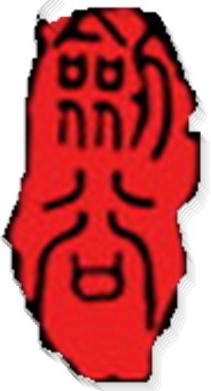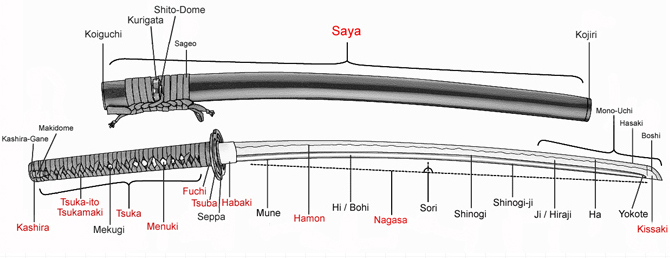|
|
Japanese sword(nihonto) glossaryThe katana(刀) is the type of Japanese longsword or backsword, it is a specific type of curved and single edged sword, traditionally used by the Japanese samurai, so it also be known as samurai sword. The katana always used for cutting and open combat. its curvature is generally gentle enough to allow for effective thrusting as well and it was predominantly used with a two-handed tsuka(grip). but many extant historical Japanese sword arts include single-handed techniques as well. it has been traditionally worn edge up, inserted in the sash from the sixteenth century.
Sword Terms
Nakago: Tang of blade Mune-Machi: Notch in the back of a blade to stop the habaki. Ha-Machi: Edge notch where blade joins tang Mekugi-Aan: Tang Hole Mei: Signature Yasuri-Mei: File marks on tang Nakago: Tang of blade Mune-Machi: Notch in the back of a blade to stop the habaki. Ha-Machi: Edge notch where blade joins tang Mekugi-Aan: Tang Hole Mei: Signature Yasuri-Mei: File marks on tang Nagasa: Blade (from tip of kissaki to munemachi) Kissaki: The point of a blade Boshi: Shape of temper line at the kissaki (point) Yokote: Line between ji and kissaki Ji/Hiraji: sword surface between the shinogi and the hamon Hamon: Temper pattern along blade edge Shinogi: Ridges on each side of a blade Shinogi-Ji: Sword flat between the mune and shinogi Mune: Back ridge of sword blade Mono-Uchi: Portion of blade 4 or 5 inches below the point. Striking point Ha: Cutting edge of a sword Sori: Curve Hi/Bohi: Groove Koshirae: Sword mountings including Saya, tsuka and Toso/Tosogu. Toso/Tosogu: Sword-furniture, I.E.: Fittings, Fuchi-Kashira; Habaki, Seppa, Menuki and Tsuba Tsuba: Sword guard Fuchi-Kashira: set of hilt collar (fuchi) and butt cap (kashira). Menuki: Ornaments under handle wrapping to improve grip Habaki: Collar around blade above the tang to fit the blade securely into scabbard Seppa: Washers to fill out space provided for tsuba on blade Tsuka: Sword handle. Ito/Tsuka ito: Braid for wrapping handle Tsuka-maki: art of wrapping the handle of a sword. Mekugi: Bamboo peg or metal rivet holding the handle on a sword Same/Same-kawa: Patch of skin from belly of giant ray, used on sword handles and sometimes on scabbards Saya: Scabbard of sword. Sageo: Cord or braid attached to kurikata on side of scabbard Koiguchi: The mouth of the scabbard or its fitting Kurikata: Scabbard (saya) fitting for attaching the sageo Kojiri: Bottom end fitting on scabbard Shito-Dome: Small collars in the kurikata and/or kashira Referenced page from: http://www.samuraisword.com/glossary/index.htm Learn More Glossary about Japanese sword blade, please click here. |

